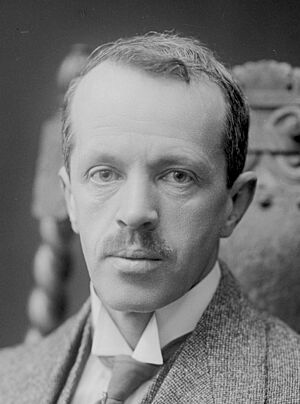Erkki Melartin facts for kids
Erkki Gustaf Melartin (born February 7, 1875, died February 14, 1937) was a Finnish composer, conductor, and teacher. He lived during a time when music was changing from the Romantic style to more modern sounds. Many people think Melartin was one of Finland's most important Romantic composers. However, his music was often less famous than that of his friend, Jean Sibelius, who is Finland's most well-known composer.
Melartin wrote six complete symphonies, which are long pieces for a whole orchestra. He also wrote an opera called Aino. This opera was based on a story from the Kalevala, which is Finland's national epic poem.
Some of Melartin's other famous works include the popular wedding song Festive March (from his music for the play Sleeping Beauty). He also wrote a symphonic poem called Traumgesicht and a violin concerto. The Blue Pearl was Finland's first big ballet. Melartin also wrote four string quartets and many songs for singers and piano. He planned to write two more symphonies, but he passed away at age 62 before finishing them.
Contents
Melartin's Musical Journey
Erkki Melartin was not only a composer but also a dedicated teacher and music director. He taught at the Helsinki Music College, which later became the Helsinki Conservatory. One of his students was the famous composer and conductor Heidi Sundblad-Halme.
From 1908 to 1911, Melartin was the conductor of the Vyborg Orchestra. Even though he had health problems, he traveled a lot. He went as far as North Africa and India. He even conducted the very first performance of Gustav Mahler's music in Scandinavia. This was a part of Mahler's Resurrection symphony, performed in 1909.
Melartin's Compositions
Even though Melartin was known for his beautiful melodies, symphonies were very important to his work. He wrote six symphonies between 1902 and 1924. He was the first Finnish composer to be influenced by Gustav Mahler's style.
His fourth symphony uses a special singing style called a vocalise. His fifth symphony is shorter and ends with a fugue and a chorale. The sixth symphony has more advanced harmonies. It starts in C minor and ends in E-flat major, reminding some people of Mahler's Resurrection symphony.
Melartin's music also includes his opera Aino. This opera tells the story of the character from the Finnish national epic, the Kalevala. He also wrote a violin concerto, four string quartets, and many pieces for the piano. His works can be divided into large pieces for orchestras and smaller pieces for groups of instruments or solo performers.
Even though Melartin lived at the same time as Jean Sibelius, his style was different. Sibelius was more famous, so Melartin's work was often not as well-known. However, Melartin's Juhlamarssi (Festive March) from his ballet Sleeping Beauty is still the most popular wedding march in Finland today!
Stage Works
- Aino, an opera in 2 acts, Op. 50 (1912)
- Sininen helmi (The Blue Pearl), a ballet, Op. 160 (1930)
- Prinsessa Ruusunen (Sleeping Beauty), music for a play, Op. 22 (1904)
Orchestral Music
- Symphony No. 1 in C minor, Op. 30 No. 1 (1902)
- Symphony No. 2 in E minor, Op. 30 No. 2 (1904)
- Symphony No. 3 in F major, Op. 40 (1906–07)
- Traumgesicht, a symphonic poem, Op. 70 (1910)
- Symphony No. 4 "Kesäsinfonia" (Summer Symphony) in E major, Op. 80 (1912)
- Symphony No. 5 "Sinfonia brevis" in A minor, Op. 90 (1915)
- Symphony No. 6, Op. 100 (1924)
- Concerto in D minor for violin and orchestra, Op. 60 (1913)
Chamber Music
Chamber music is written for a small group of instruments, often played in a smaller room or "chamber."
- String Quartet No. 1 in E minor, Op. 36 No. 1 (1896)
- Sonata for violin and piano (1899)
- String Quartet No. 2 in G minor, Op. 36 No. 2 (1900)
- String Quartet No. 3 in E♭, Op. 36 No. 3 (1902)
- String Quartet No. 4 in F, Op. 62 (1910)
- Nocturne for violin and piano, Op. 64 No. 1
- String Trio, Op. 133 (1927)
- Sonata for flute and harp, Op. 135a (1927)
Piano Music
- Marionetteja (Marionnettes), Suite for piano 4 hands, Op. 1 (1899)
- Lastuja I (Chips I), 6 pieces, Op. 7 (1900)
- Lastuja II (Chips II), 6 pieces, Op. 9 (1900)
- Surullinen puutarha (The Melancholy Garden), 5 Pieces, Op. 52 (1908)
- 24 Preludes, Op. 85 (1913–20)
- Fantasia apocaliptica, Op. 111 (1921)
- 6 Pieces, Op. 118 (1923)
- No. 2 The Mysterious Forest
Vocal Music
Vocal music is written for singers, often with piano accompaniment.
- 3 Songs for voice and piano, Op. 13
- Kansanlaulua Käkisalmelta (Folk Songs from Kexholm), Op. 55
- 5 Songs for voice and piano, Op. 69



